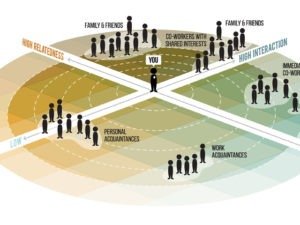Managing corporate culture through change can keep your organization afloat when it’s most needed.
Organizational change can be good and it can be bad, but one constant throughout is that change produces uncertainty. That uncertainty sits and simmers with employees, who are concerned about their futures, the future of the organization, and what’s going to be valued at the organization when the change settles.
A lot of conversations about managing corporate culture myopically focus on its tangible elements. The programs, resources, and gatherings leaders spend top dollar to organize. While these material components are critical, often unifying elements of an organization, culture encompasses so much more.
In its purest sense, company culture is an expression of what your workplace values. Whether you value learning and productivity, empathy and purpose, or authority and order, these values ripple through every element of your organization’s identity. They live in the tone, cadence, and content of your communication with employees. They exist in the formal documentation of your workplace rules, and the informal “rituals” and habits you practice daily. They manifest in the emotions employees feel as they carry out their work. They’re even present in how employees carry out their work. And yes, they’re embodied in the tangible programs and initiatives mentioned before.
Free eBook: Why Company Culture Matters: Insights from 17 Experts
By managing corporate culture through change, you are making clear what values matter moving forward, and setting a template for how employees can succeed in the organization’s future. And that template couldn’t be more necessary, as per Columbia Business School, more than 50% of executives agree culture drives workplace productivity, creativity, profitability, firm value, and even growth rates.
Pointers on managing corporate culture through change
Mind the change curve
So you’ve developed your change strategy. It took you several months, and you don’t even know how many meetings, but you finally settled on a plan to implement changes that makes you happy. Once you roll it out, employees should be expected to get on board immediately, right? Wrong. This is a common fallacy that many leaders fall victim to because the decision-makers guiding change have already been over the “change curve.” This is the process of questioning, processing, and ultimately accepting the need for organizational change.
Some people are able to get over the change curve quickly, others need more time. But all too often, employees are not given even a remotely acceptable amount of time to come to terms with changes that leaders have had months to process. As you roll out your changes, consider what your employees are experiencing. Where possible, avoid forcing your workforce through abrupt changes by building in time for them to process and ask questions, and be proactive about participating in these conversations.
Make communications count
Speaking of the change curve, communication is one of the most important things to keep up while managing corporate culture in these transitions. Employees want to hear what’s important and how it’s going to affect them in a frequent, timely manner. More often than not, leaders don’t stick the landing here either. They tend to fall back on two styles of communication with employees, communicating too much or not at all. Both can be equally overwhelming to employees.
Strive for that sweet spot Goldilocks would call “just right.” Establish meaningful feedback loops with employees across every channel in your internal communications portfolio. Find out what questions matter most to your different employee segments, answer them to the best of your ability, and make sure to close the loop with every party so they know their voices were heard.
Consistent actions make for authentic cultures
Nota bene about your communications: you have to backup your words with consistent, observable behaviors. As Mahatma Ghandi once said, “You must be the culture change you want to see in your organization.” …Maybe that’s not the exact quote, but the principle is key.
As leaders detail impending changes, be they cultural, hierarchical, process-oriented, or anything else, employees will be looking for signs that they’re real. They need reassurance that you actually value what you say you’re valuing. In other words, authenticity. So, if a leader says integrity is a new core value, that person, more than anyone else in the company, is responsible for performing their job with integrity every day, until it’s clear to employees what integrity looks like. If the company announces it’s becoming a flat organization, leaders can’t get upset when lower-level employees try to act with a newfound authority. Instead, they’ll need to encourage ideation from employees across all areas of the company.
If you stay consistent, employees will begin to model the new desired change behaviors because they’ll perceive your efforts as authentic and sincere. When they do, make sure you identify your new company influencers and champion their behaviors to others. Chairman and President of Ameren Transmission Shawn Shuckar estimates that only about 30% of people are really ready for change, so take any chance you get to reinforce the good behaviors you see in others.
Putting employees first pays dividends in the long run
Change tends to bring unwanted consequences. Many times, leaders are working with reduced budgets that require sacrifices to be made, and in extreme circumstances layoffs come up in the conversation. When layoffs are on the table, it creates something of a Catch 22. The organization doesn’t have the resources to operate at full capacity, and thus needs to simultaneously cutdown on headcount while asking the employees it retains to work harder in the wake. But as any reader of Gather Around knows, relationships in the workplace–between all employees–are the secret to a culture that’s highly-engaged and high-performing. Simply put, relationships are what motivate employees to collaborate and innovate, and work harder, faster. Cuts to headcount, then, cut out the relationships that make your organization thrive.
Let us not be mistaken here: we recognize that layoffs are simply unavoidable in many cases, and that no employer takes pleasure in letting someone go. However, precedent shows that layoffs are not an inevitability, and good things come to organizations that seek solutions to avoid them.
The Great Recession took an overwhelming toll on many organizations. Barry-Wehmiller, a manufacturing technology supplier firm, saw 40% of its business disappear overnight. Similarly, Southwest Airlines, along with the entire aviation industry, was in turmoil following the tragedy of 9/11. At most organizations, layoffs were a common response to the financial devastation brought on by both these crises. But workplace relationships are at the core of the cultural ethos at Barry-Wehmiller and Southwest. Incredibly, both organizations pulled through by seeking out creative solutions that allowed them each to avoid laying off a single employee. As a direct result of these organizations’ unconventional approach, Barry-Wehmiller and Southwest reaped financial rewards in times where their peers took significant losses. You can read more about these incredible stories of perseverance, and the remarkable success that came after here.
Get creative to preserve what’s important
In times of change, culture is often put on the chopping block. The things leaders set in place while managing corporate culture, the initiatives that mobilized people and brought them together, the programs that recognize the hard work everyone’s put out in the year, the training and development modules keeping employees’ skills sharp, these all start looking expendable when budgets become a concern.
To quote Bonfyre’s Director of Employee Experience Rob Seay, who happens to know quite a bit about maintaining organizational culture, “wholesale cuts are careless responses to problems better solved with creative thinking.” Consider the ways you can keep the spirit of your culture programs alive as you adjust to your changes. For example, you may not have the budget to keep running your entire rewards and recognition program. But you don’t need material rewards to practice recognition at work. Informal, social praise gets the job done, and is even better than you think at motivating performance and making employee engagement programs more effective.
Managing corporate culture may not always come up when leaders craft a change strategy, but it should. Leaders that preserve what matters most to their culture, and mind the actions, communications, and rituals they practice even in turbulent times, want to ensure their organizations and employees thrive through change. Leaders that don’t merely want to survive it.



 5 min
5 min




